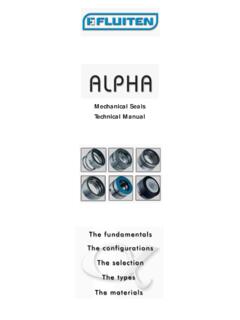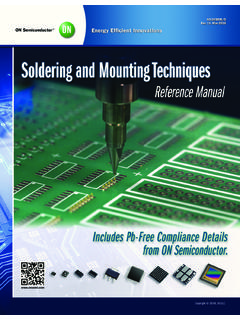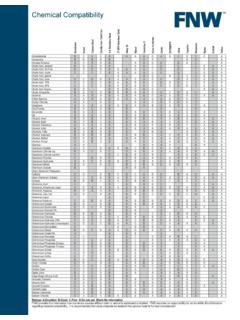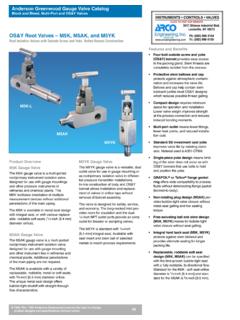Transcription of Mechanical Seals Technical Manual - fluiten.it
1 Mechanical SealsTechnical ManualTHE FUNDAMENTALSThe Mechanical liquid film ..3 Leakage ..4 Degree of ratio ..5 Unbalanced CONFIGURATIONSS ingle internal external seal ..11 Back-to-back double seal ..12 Tandem double seal ..13 Dual seal ..14 Face-to-face seal ..14 THE SELECTIONC ooling system and API planes ..19 Selection of Mechanical Seals ..19 Clean, not harmful, neutral, not flammable products ..21 Fluids crystallizing when in contact with atmosphere ..21 Acid products ..22 Hot liquids ..22 Aqueous solutions prone to solidify or produce sediments ..23 Toxic, poisonous or highly viscous fluids ..24 Abrasive fluids ..25 Hot water ..26 THE TYPESS ingle seal with single Seals ..30 Seals with protected springs ..31 Elastomeric bellow Seals ..32 PTFE bellow seal.
2 33 Metal bellow Seals ..34 External Seals ..35 Cartridge Seals ..36 Stationary OOFF CCOONNTTEENNTTSSTTAABBLLEE OOFF CCOONNTTEENNTTSSiALPHAALPHAPageTHE MATERIALSSeal face ..42 Chromium steel ..42 Ceramic ..42 Tungsten carbide ..43 Silicon carbide ..43 TAB. I - FLUITEN code seal face II - Seal face III - Fisical and Mechanical property seal face ..46 Secondary seal materials ..47 Elastomers ..47 Nitrilic rubber .. elastomeric (Polytetrafluoroethylene)..49 FEP (Fluoruro of ethylene e propylene) ..50 Grafoil and asbestos free ..50 TAB. IV - FLUITEN code secondary V - FLUITEN code metallic parts ..51 TTAABBLLEE OOFF CCOONNTTEENNTTSSTTAABBLLEE OOFF CCOONNTTEENNTTSSiiALPHAALPHAPageTTHHEE FFUUNNDDAAMMEENNTTAALLSSTTHHEE FFUUNNDDAAMMEENNTTAALLSSTTHHEE FFUUNNDDAAMMEENNTTAALLSSTTHHEE FFUUNNDDAAMMEENNTTAALLSS1 ALPHAALPHAThe Mechanical sealMechanical Seals have the purposeof preventing leakage of a fluid(liquid or gaseous) through theclearance between a shaft and thefluid container.
3 ( )The main components of amechanical seal are the seal ringson which a Mechanical force isacting, generated by springs orbellows , and an hydraulic force, generated by the process fluid seal ring which rotates with the shaft is called the "rotary ring" ; theseal ring fixed on the casing of the machinery is called the "stationary ring".Secondary Seals are required to perform static sealing between rotary ringsand shafts and also between stationary rings and the casing of the O-Ringsare usually used as secondary Seals but alternativesystems can be used, as described in the following sections. ( )Fig. 1 Stationary Ring GasketRotary Ring GasketStationary RingROTARY SHAFTR otary RingSpringSTUFFING BOXFig. 2 Typically Mechanical Seals are installed on pumpsand mixers.
4 ( & 4)On both of the above set-ups, the installation of a suitable device is requiredto seal the fluid contained in the casing. TTHHEE FFUUNNDDAAMMEENNTTAALLSSTTHHEE FFUUNNDDAAMMEENNTTAALLSS2 ALPHAALPHAFig. 3 Fig. 4 The liquid filmIn order to minimize the amount of friction between the seal rings an efficientlubricationis faces can be lubricated by the process fluid or, with double mechanicalseals, by a proper auxiliary fluid (see chapter relevant to configurations).An stable and complete layer of lubrication greatly affects the performanceand the life of a Mechanical seal. ( )TTHHEE FFUUNNDDAAMMEENNTTAALLSSTTHHEE FFUUNNDDAAMMEENNTTAALLSS3 ALPHAALPHAFig. 5 Hydraulic forcegenerated by pressure instuffing boxVAPORIZATION OFTHE LIQUID FILMDRY-RUNNINGSITUATIONO pening forcesgenerated by liquidfilm pressureSTABLE LIQUIDFILMIn order to insure good lubrication and sufficient cooling of the seal rings, thecorrect selection of a Mechanical seal shall take into consideration thefollowing parameters:Process fluid temperatureVaporisation pressureat operating temperatureProcess fluidcharacteristics Shaft speed(see also chapter relevant to selection)Concepts and principles above discussed are valid for all Mechanical sealoperating with a liquid fluid.
5 Dry-running Seals and gas- Seals operate ondifferent principles and shall be considered further Mechanical Seals produce reason lies in the previously discussed theory of lubrication ; it is obviousthat a stable lubrication layer means a certain amount of can be calculated and depends on several factors as rotationalspeed, fluid pressure and characteristics, and balancing ratio. But theequipment on which the Mechanical seal is installed can have some influenceon it too. Often leakage is so reduced that it cannot be detected(vaporisation).Degree of freedomThe elastic components of a Mechanical seal (spring or bellow, gaskets) areof paramount importance for good gasket mounted on the seal ring pushed by the spring or bellow (usuallythe rotary ring) has to follow the movement of the ring induced byTTHHEE FFUUNNDDAAMMEENNTTAALLSSTTHHEE FFUUNNDDAAMMEENNTTAALLSS4 ALPHAALPHATTHHEE FFUUNNDDAAMMEENNTTAALLSSTTHHEE FFUUNNDDAAMMEENNTTAALLSS5 ALPHAALPHA unavoidable phenomena like vibrations, misalignment and shaft run-out andfor this reason it's called "dynamic" ( )
6 It follows that such parameters as working length, gasket compatibilitywith the process fluid, dimensionand finishingof the shaft have to becarefully considered for good application of a Mechanical ratioIf we consider a piston on which a constant pressure is applied we know thatthe force produced shall be proportional to the area of the piston Mechanical Seals , in addition to the closing force generated by the springsor bellow, an hydrostatic force generated by the fluid pressure acts on theseal previously discussed the fluid pressure also penetrates between the sealfaces, producing a lubrication film and generating an opening ratio between the forces which are closing the seal ring and the oneswhich are opening the seal ring is called the "balancing ratio".
7 Radial movementAxial movementWorking LengthFig. 6 TTHHEE FFUUNNDDAAMMEENNTTAALLSSTTHHEE FFUUNNDDAAMMEENNTTAALLSS6 ALPHAALPHAWhen the balancing ratio is greater than one , we have an unbalanced the other cases we have a balanced seal .The dimensions needed for a balanced seal are obtainable thanks to a smallnotchplaced on the sleeve or on the body of the seal itself. Unbalanced sealsGenerally unbalanced Seals have good performance when subjected tovibrations, misalignments or cavitation; they are cheaper and theirapplication does not require shaft or sleeve notching. The main limitation in the application of unbalanced Mechanical Seals is theoperating pressures produce an excessive closing force which affects the stabilityof the liquid film between the seal faces, inducing overheating and prematurewearing.
8 ( )AhAfK= Ah/Af Ah>Af K>1 Opening forceClosing forceFig. 7d2d1d2d3Ah=(d22-d12)- /4Af=(d22-d32)- /4Ah= Anualar area on which the pressure is actingAf= Sliding faces areaBalanced sealsHigh pressure and high speed obviously generate proportionally high valuesof friction Seals address this problem with a reduced closing force, aspreviously in cases where a high value of vapour pressure has to be considered, abalanced Mechanical seal is the right standard defines as "flashing" all hydrocarbons that have a vapourpressure higher that 1 barg and for these fluids a double or tandem balancedseal has to be provided. ( )TTHHEE FFUUNNDDAAMMEENNTTAALLSSTTHHEE FFUUNNDDAAMMEENNTTAALLSS7 ALPHAALPHAAhAfFig. 7ad2d1d2d3Ah=(d22-d12)- /4Af=(d22-d32)- /4 Opening forceClosing forceAh= Anualar area on which the pressure is actingAf= Sliding faces areaK= Ah/Af Ah<Af K<1 TTHHEE CCOONNFFIIGGUURRAATTIIOONNSSTTHHEE CCOONNFFIIGGUURRAATTIIOONNSSTTHHEE CCOONNFFIIGGUURRAATTIIOONNSSTTHHEE CCOONNFFIIGGUURRAATTIIOONNSS11 ALPHAALPHAS ingle internal sealThis is the most popular and efficient configuration for the most is called internal because of itsbeing completely submerged inthe product.
9 The balancing ratio isdesigned for pressure actingoutside the seal, thereforeusually, if installed as an externalseal , the fluid pressure will causetranslation of the stationary ringand excessive separation of theseal faces. ( )Single external sealIn this execution the sealedproduct is inside the seal and theoutside part of the rotary ring isexposed to the atmosphere.( )It is employed with aggressivefluids which can chemically attackmaterials commonly used forinternal Seals or when the use of special materials is considered this type of seal often there are no metallic parts in contact with theproduct or, if there are any, special materials such as Hastelloy or Titaniumare rotary ring and the stationary ring (in contact with process fluid) can bemade of graphite, ceramic or silicon can be in fluoroelastomer, PTFE or 8 Fig.
10 9 ProductAtmosphereProductAtmosphereThe application of external Seals is often employed in top entry mixersbecause of an easy installation and the possibility to carry out an efficientcooling of the stationary ring, required for dry running double sealThis configuration is recommended with critical products ( gaseous ,abrasive , toxic or lethal) and generally when no emissions in the atmosphereare back-to-backlay-out, so called because the two Seals are placedliterally back to back, gives the possibility to create a barrier made of apressurised auxiliary fluid not harmful to the lubrication of the seal faces is carried out by the auxiliary fluid whichshould be compatible with the process fluid.( )In a back-to-back configuration an internal pressurisation having a valuegreater than the process fluid (at least 1 bar or 10% more) is required inorder to avoid opening of the seal (as explained in chapter relevant tointernal single Seals ) and to provide an efficient barrier against leakage ofprocess fluid into the CCOONNFFIIGGUURRAATTIIOONNSSTTHHEE CCOONNFFIIGGUURRAATTIIOONNSS12 ALPHAALPHAFig.




